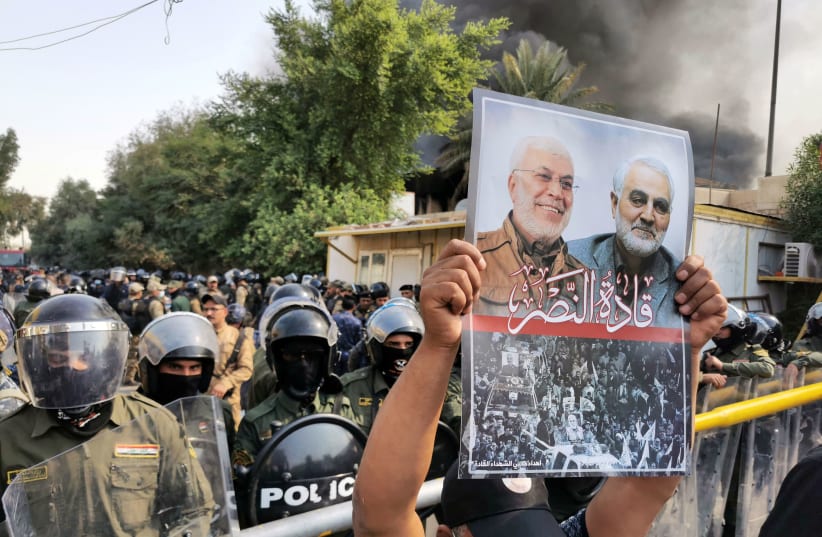In 2019, the deputy head of the Hashd al-Shaabi, Abu Mahdi al-Muhandis, vowed to establish an air force. The Hashd is known as the Popular Mobilization Forces (PMF), a group of mostly Shi’ite militias in Iraq that are an official paramilitary force.
First established seven years ago to fight ISIS, the PMF has morphed into a huge organization. On Saturday, they showcased some of their new “air force,” which consists of Iranian-designed drones and UAVs of the type that have been used increasingly in attacks on US forces in Iraq.
Muhandis was killed in a US drone strike in January 2020, but his air force lives on. “A statement by the PMF circulated through Iraqi news outlets said that Muhandis had ordered the formation of the air force directorate, appointing Salah Mahdi Hantoush as its caretaker,” Radio Farda reported in September 2019.
Now, images have emerged of the PMF with drones on trucks, which they intend to show in a parade to celebrate the anniversary of a fatwa by Ayatollah Ali Sistani that called on men to join these militias. Many of these groups, such as Badr, Kataib Hezbollah, Haraka Hezbollah al-Nujaba and Asaib Ahl al-Haq, predate the PMF but are now part of it, and they are linked to the Iranian Islamic Revolutionary Guard Corps (IRGC) and its Quds Force.
Muhandis worked closely with Quds Force commander Qasem Soleimani, and he and Soleimani were killed in the same US airstrike.
The use of drones by these groups, often supplied by Iran, dates to at least 2019 and likely beforehand. They used drones against ISIS and against Kurds in an Iranian attack in Koya. In 2014, “a commander of Kataib Hezbollah, an Iraqi militia closely linked to Iran, using the nickname Abu Abdullah, told Reuters that Iran had provided training for operating drones, which were mostly used to target Islamic State positions,” Radio Farda reported.
In May 2019, Kataib Hezbollah allegedly used drones to strike at Saudi Arabia, and it likely used them again this January against Saudi Arabia. The evidence for the drone attacks from Iraq on Riyadh implicates Kataib Hezbollah and other pro-Iran militias in Iraq.
We have documented these attacks and the increasing role drones play in Iraq over the years. That the PMF is now parading the drones, like Iran has done, shows how they are unveiling them in the same way that Hamas has done with its new drones based on the Iranian Ababil and Houthi Qasef.
Drone components sent to the Houthis have been intercepted by the US Fifth Fleet over the past few years. The Houthi Qasef is a kamikaze drone that is widely used against Saudi Arabia. Iran also used drones to attack Saudi Arabia in September 2019.
Now, the Iranian drone threat in Iraq has expanded through the PMF. From the recent images, we know that the drones are roughly equal in length to pickup trucks used by the PMF, apparently old Toyota Hilux models, which have a reputation of being pretty much indestructible. Video shows the drones being prepared for the parade.
Kenneth McKenzie, the top US general in CENTCOM, has warned for a year about drone threats. Last year, he was concerned about off-the-shelf drones being armed with IEDs. But this year, he has been discussing the Iran threat in Iraq.
There have been at least five drone attacks, most recently on June 10 in Baghdad, and June 6, when drones, likely operated by Iranian-backed militias, attacked Ain al-Asad Airbase before they were shot down.
On May 8, another drone incident took place, and in April, a drone attacked a secret CIA hangar at Erbil International Airport in the Kurdish Region of Iraq. There was another drone attack on May 11.
The parade of drones in Iraq appears to showcase that the PMF now has an air force, as Muhandis promised it would. This comes as there have been increasing attacks on US contractors based at Balad Air Base in Iraq who are responsible for upkeep of Iraqi F-16s and other air assets.
Iraq’s F-16s were grounded due to lack of maintenance after Lockheed crews had been evacuated because of the continued pro-Iran militias’ attacks on Balad and other facilities, The New York Times reported in May.
This means that as Iraq’s modern air force has fallen into disrepair, its new Iran-origin drone air force for the militias, a kind of IRGC air force inside Iraq, has mushroomed to take shape. The end result may be that Iraq’s air force, meaning its drone force, is controlled by pro-Iran militias, while the actual Iraqi air force falls apart.
